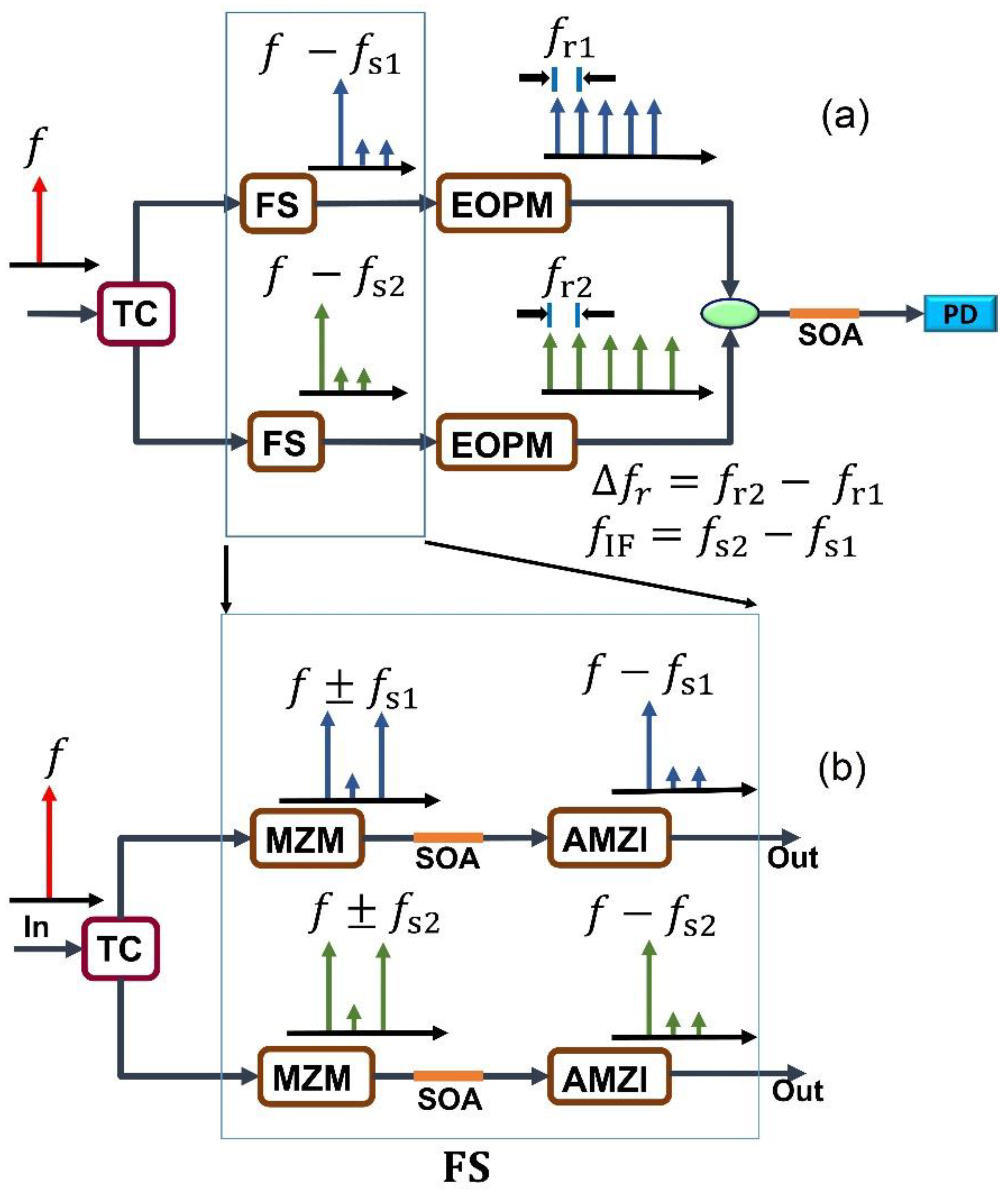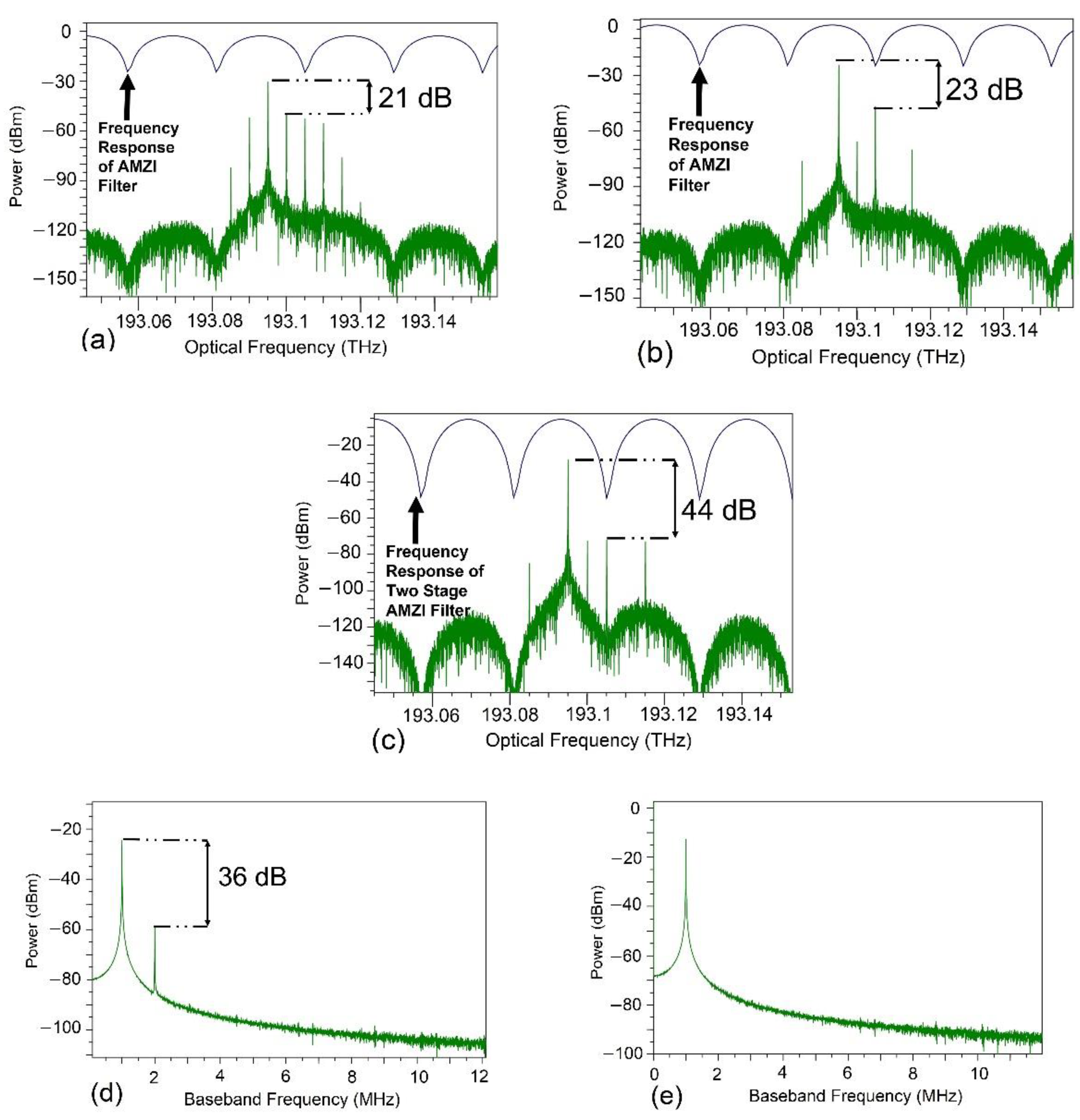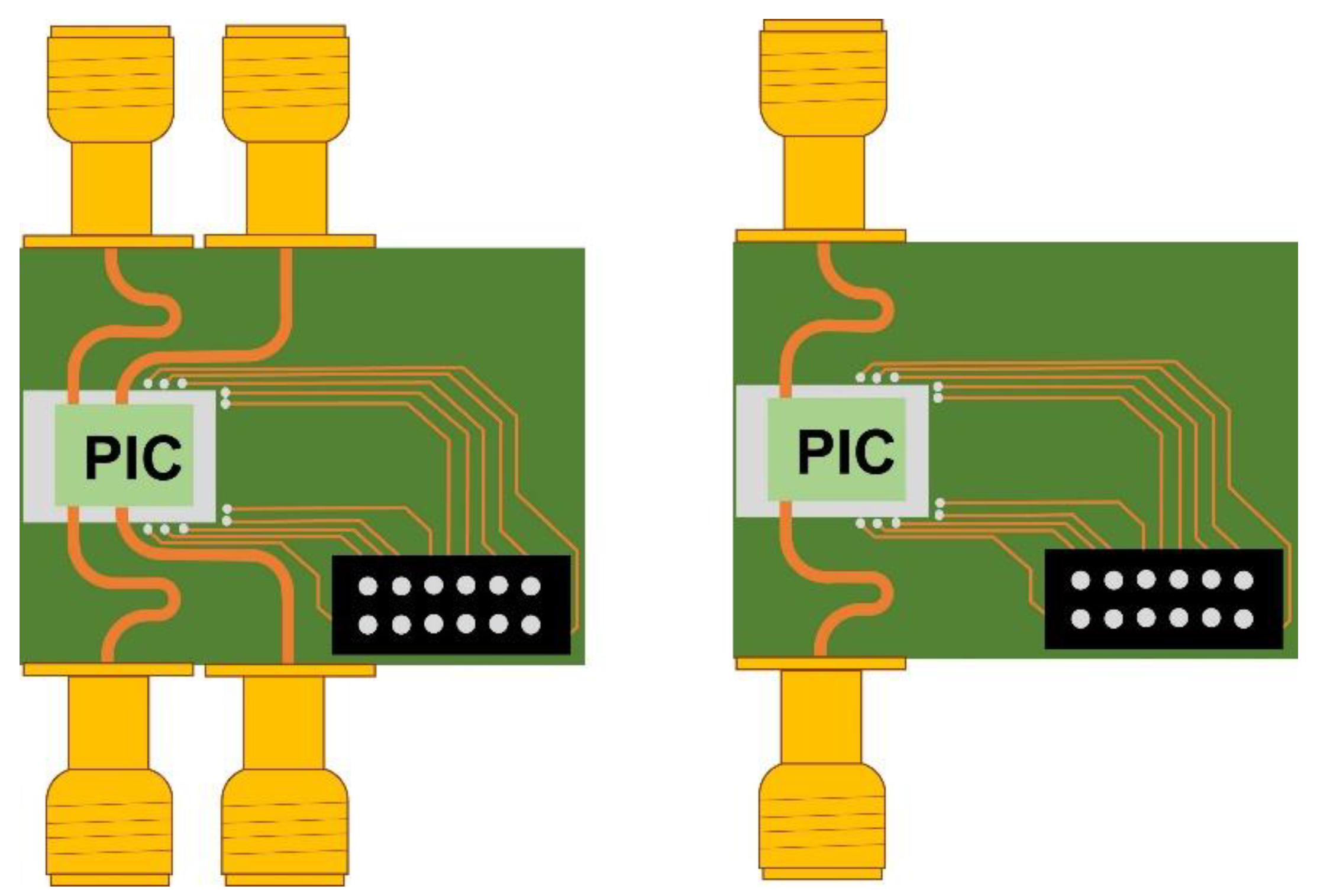Photonic Integrated Frequency Shifter Based on Double Side Band Modulation: Performance Analysis
Abstract
:1. Introduction
2. Analytical Model of MZM Structures
- : Is the voltage needed to reach a phase shift equal to π;
- : Is the RF voltage applied on the respective EOPM;
- : Coupler Splitting Ratio.
- d: distance between conductors;
- : Vacuum operation wavelength;
- L: Length of the waveguide;
- r: Linear electro-optic coefficient;
- n: Refraction index with no electric field applied.
3. Architecture of the DSB-SC Based OFS
3.1. Working Principle
3.2. Results
4. Discussion
5. Conclusions
Author Contributions
Funding
Institutional Review Board Statement
Informed Consent Statement
Acknowledgments
Conflicts of Interest
References
- Langdon, R.J.; Yousefi, P.D.; Relton, C.L.; Suderman, M.J. A Bipolar, Two Component Laser-Doppler Velocimeter. J. Phys. E Sci. Instrum. 1975, 8, 729. [Google Scholar] [CrossRef]
- Yoshimura, T.; Syoji, Y.; Wakabayashi, N.; Suzuki, N. Optical Frequency Shifting for Rayleigh Scattering Spectroscopy (Laser Velocimeters). J. Phys. E Sci. Instrum. 1978, 11, 777–780. [Google Scholar] [CrossRef]
- Castellini, P.; Martarelli, M.; Tomasini, E.P. Laser Doppler Vibrometry: Development of Advanced Solutions Answering to Technology’s Needs. Mech. Syst. Signal Process. 2006, 20, 1265–1285. [Google Scholar] [CrossRef]
- Supradeepa, V.R.; Long, C.M.; Wu, R.; Ferdous, F.; Hamidi, E.; Leaird, D.E.; Weiner, A.M. Comb-Based Radiofrequency Photonic Filters with Rapid Tunability and High Selectivity. Nat. Photonics 2012, 6, 186–194. [Google Scholar] [CrossRef] [Green Version]
- Lu, H.H.; Lukens, J.M.; Peters, N.A.; Odele, O.D.; Leaird, D.E.; Weiner, A.M.; Lougovski, P. Electro-Optic Frequency Beam Splitters and Tritters for High-Fidelity Photonic Quantum Information Processing. Phys. Rev. Lett. 2018, 120, 30502. [Google Scholar] [CrossRef] [PubMed] [Green Version]
- Yoo, S.J.B. Wavelength Conversion Technologies for WDM Network Applications. J. Light. Technol. 1996, 14, 955–966. [Google Scholar] [CrossRef]
- Barretto, E.C.S.; Hvam, J.M. Photonic Integrated Single-Sideband Modulator/Frequency Shifter Based on Surface Acoustic Waves. Silicon Photonics Photonic Integr. Circuits II 2010, 7719, 771920. [Google Scholar] [CrossRef]
- Shao, L.; Sinclair, N.; Leatham, J.; Hu, Y.; Yu, M.; Turpin, T.; Crowe, D.; Loncar, M. Integrated Lithium Niobate Acousto-Optic Frequency Shifter. Opt. InfoBase Conf. Pap. 2020, 6–7. [Google Scholar] [CrossRef]
- Spuesens, T.; Li, Y.; Verheyen, P.; Lepage, G.; Balakrishnan, S.; Absil, P.; Baets, R. Integrated Optical Frequency Shifter on a Silicon Platform. In Proceedings of the 2016 Conference Lasers Electro-Optics, CLEO 2016, San Jose, CA, USA, 5–10 June 2016; Volume 2, pp. 3–4. [Google Scholar] [CrossRef] [Green Version]
- Sueta, T.; Shikama, S. Integrated Optical SSB Modulator/Frequency Shifter. IEEE J. Quantum Electron. 1981, 17, 2225–2227. [Google Scholar] [CrossRef]
- Lauermann, M.; Weimann, C.; Knopf, A.; Heni, W.; Palmer, R.; Koeber, S.; Elder, D.L.; Bogaerts, W.; Leuthold, J.; Dalton, L.R.; et al. Integrated Optical Frequency Shifter in Silicon-Organic Hybrid (SOH) Technology. Opt. Express 2016, 24, 11694. [Google Scholar] [CrossRef] [Green Version]
- Betancur-Pérez, A.; Martín-Mateos, P.; de Dios, C.; Acedo, P. Design of a Multipurpose Photonic Chip Architecture for Thz Dual-Comb Spectrometers. Sensors 2020, 20, 6089. [Google Scholar] [CrossRef]
- Anon. PASSIVE OPTICAL COMPONENTS. Electro-Opt. Syst. Des. 1974, 6. [Google Scholar] [CrossRef]
- Hui, R.; O’Sullivan, M. Basic Instrumentation for Optical Measurement. Fiber Opt. Meas. Tech. 2009, 129–258. [Google Scholar] [CrossRef]
- Kaminow, I.P.; Koch, T.L. Optical Fiber Telecommunications IIIB. Opt. Fiber Telecommun. IIIB 2012, B, 1–515. [Google Scholar] [CrossRef]
- Akiyama, S.; Itoh, H.; Sekiguchi, S.; Hirose, S.; Takeuchi, T.; Kuramata, A.; Yamamoto, T. Inp-Based Mach—Zehnder Modulator With Capacitively Loaded Traveling-Wave Electrodes. J. Light. Technol. 2008, 26, 608–615. [Google Scholar] [CrossRef]








Publisher’s Note: MDPI stays neutral with regard to jurisdictional claims in published maps and institutional affiliations. |
© 2022 by the authors. Licensee MDPI, Basel, Switzerland. This article is an open access article distributed under the terms and conditions of the Creative Commons Attribution (CC BY) license (https://creativecommons.org/licenses/by/4.0/).
Share and Cite
Betancur-Pérez, A.; de Dios, C.; Acedo, P. Photonic Integrated Frequency Shifter Based on Double Side Band Modulation: Performance Analysis. Photonics 2022, 9, 793. https://doi.org/10.3390/photonics9110793
Betancur-Pérez A, de Dios C, Acedo P. Photonic Integrated Frequency Shifter Based on Double Side Band Modulation: Performance Analysis. Photonics. 2022; 9(11):793. https://doi.org/10.3390/photonics9110793
Chicago/Turabian StyleBetancur-Pérez, Andrés, Cristina de Dios, and Pablo Acedo. 2022. "Photonic Integrated Frequency Shifter Based on Double Side Band Modulation: Performance Analysis" Photonics 9, no. 11: 793. https://doi.org/10.3390/photonics9110793
APA StyleBetancur-Pérez, A., de Dios, C., & Acedo, P. (2022). Photonic Integrated Frequency Shifter Based on Double Side Band Modulation: Performance Analysis. Photonics, 9(11), 793. https://doi.org/10.3390/photonics9110793




